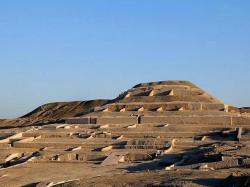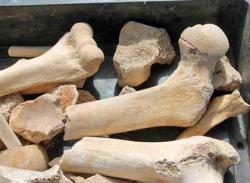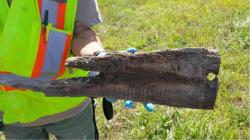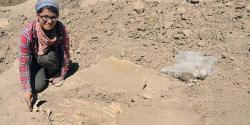INSTITUT SUPERIEUR D'ANTHROPOLOGIE
INSTITUTE OF ANTHROPOLOGY
ONLINE COURSES / COURS A DISTANCE
FALL TERM : OCTOBER 2015
REGISTER NOW
PEROU –  Cahuachi - The large ceremonial center of Cahuachi has much more to explore and is facing conservation threats. “Cahuachi Sanctuary is bigger than Chan Chan,” says Italian archaeologist, Giuseppe Orefici, according to a press release provided to Living in Peru. The archaeologist has been excavating and conducting research on the ceremonial site in Nazca, southern Peru, for the last couple decades. As a major proponent of research and preservation of the site, he expresses concern over its future with the climate phenomenon of El Niño on the horizon. Cahuachi was once the capital of the Nazca culture, from the period 450 B.C.- 450 A.D.. “It is the largest ceremonial center in the world and of this dimension, there are none like it,” says Orefici. In other words, it is the largest ceremonial center made of mud, and larger than the pre-Colombian citadel of Chan Chan located in Trujillo, northern Peru. “The influence of Cahuachi arrived until the outskirts of the Tablada de Lurin (Lima), and to the east reached Huanuco, Huancayo (Junin) and Ayacucho, while to the south, it spread to the town of Acari (Arequipa),” explained the Orefici. In the two decades of work he’s conducted, Orefici and his team have only excavated 1% of the entire 24 km2 of the sanctuary. “It has been a job of 20 years and my preoccupation is the imminent arrival of El Niño that could crack its principal structures. I can indicate that each 500 years a Mega El Niño arrives and I believe that we are in the period of one Mega violent Niño,” said Orefici.
Cahuachi - The large ceremonial center of Cahuachi has much more to explore and is facing conservation threats. “Cahuachi Sanctuary is bigger than Chan Chan,” says Italian archaeologist, Giuseppe Orefici, according to a press release provided to Living in Peru. The archaeologist has been excavating and conducting research on the ceremonial site in Nazca, southern Peru, for the last couple decades. As a major proponent of research and preservation of the site, he expresses concern over its future with the climate phenomenon of El Niño on the horizon. Cahuachi was once the capital of the Nazca culture, from the period 450 B.C.- 450 A.D.. “It is the largest ceremonial center in the world and of this dimension, there are none like it,” says Orefici. In other words, it is the largest ceremonial center made of mud, and larger than the pre-Colombian citadel of Chan Chan located in Trujillo, northern Peru. “The influence of Cahuachi arrived until the outskirts of the Tablada de Lurin (Lima), and to the east reached Huanuco, Huancayo (Junin) and Ayacucho, while to the south, it spread to the town of Acari (Arequipa),” explained the Orefici. In the two decades of work he’s conducted, Orefici and his team have only excavated 1% of the entire 24 km2 of the sanctuary. “It has been a job of 20 years and my preoccupation is the imminent arrival of El Niño that could crack its principal structures. I can indicate that each 500 years a Mega El Niño arrives and I believe that we are in the period of one Mega violent Niño,” said Orefici.
http://www.peruthisweek.com/news-cahuachi-sanctuary-is-bigger-than-chan-chan-says-archaeologist-107304
ROYAUME UNI –  Long Bredy - First Dorset burials from period of early iron usage in Britain found by archaeologists in Long Bredy. Archaeologists carrying out a watching brief on routine drainage and sewage works at an 18th century Dorset cottage have been forced to halt digging after the crouched skeletons of three young people from the Bronze or Iron Age were discovered in a trench. Radiocarbon dating suggests the bodies were buried between 800 and 600 BC at Long Bredy, a village between Dorchester and Bridport . The trio are all thought to have been between 18 and 25 years old. “The remains are of three teenage or young adults, probably crouched, all from around the period when the first iron was being used in this country. No other burials in Dorset have been identified from this time.
Long Bredy - First Dorset burials from period of early iron usage in Britain found by archaeologists in Long Bredy. Archaeologists carrying out a watching brief on routine drainage and sewage works at an 18th century Dorset cottage have been forced to halt digging after the crouched skeletons of three young people from the Bronze or Iron Age were discovered in a trench. Radiocarbon dating suggests the bodies were buried between 800 and 600 BC at Long Bredy, a village between Dorchester and Bridport . The trio are all thought to have been between 18 and 25 years old. “The remains are of three teenage or young adults, probably crouched, all from around the period when the first iron was being used in this country. No other burials in Dorset have been identified from this time.
http://www.culture24.org.uk/history-and-heritage/archaeology/art534343
ROYAUME UNI –  Perranporth - Skeletons uncovered during last year’s excavation of St Piran’s Oratory at Perranporth have been dated to around 800AD and described by archaeologists as “nationally significant” discoveries. The bones are now thought to confirm an early Christian presence at the site. James Gossip of Cornwall Archaeology Unit, who led the excavations, said: “The clearance of sand during the recent re-excavation uncovered the remains of several skeletons to the north-west of the oratory. They buried approximately 24 inches below the surface. It was necessary to record and excavate these skeletons which were later transferred to the lab, where they were cleaned and analysed by osteoarchaeologist Richard Mikulski. “Samples from two burials were then selected for radiocarbon dating and sent to the Scottish Universities Environmental Research Centre. The first sample, taken from the skeleton of a child buried on its side in a flexed position, produced a date suggesting burial in the 8th or 9th centuries AD. The second, also a child, appears to have been buried probably in the 9th century AD.”
Perranporth - Skeletons uncovered during last year’s excavation of St Piran’s Oratory at Perranporth have been dated to around 800AD and described by archaeologists as “nationally significant” discoveries. The bones are now thought to confirm an early Christian presence at the site. James Gossip of Cornwall Archaeology Unit, who led the excavations, said: “The clearance of sand during the recent re-excavation uncovered the remains of several skeletons to the north-west of the oratory. They buried approximately 24 inches below the surface. It was necessary to record and excavate these skeletons which were later transferred to the lab, where they were cleaned and analysed by osteoarchaeologist Richard Mikulski. “Samples from two burials were then selected for radiocarbon dating and sent to the Scottish Universities Environmental Research Centre. The first sample, taken from the skeleton of a child buried on its side in a flexed position, produced a date suggesting burial in the 8th or 9th centuries AD. The second, also a child, appears to have been buried probably in the 9th century AD.”
http://www.westernmorningnews.co.uk/Scientific-tests-reveal-St-Piran-Oratory/story-27629955-detail/story.html
USA –  Northfield - A historic hitching post and a piece of a wooden frame were revealed at the site of an old Northfield gas station on lower Main Street during a recent archaeological dig. Joe Graveline, Northfield Historical Commission member and president of the Nolumbeka Project, conducted an archaeological study on the grounds of the town’s first fort settlement of 1673. He said the fort only lasted two years before it was burned to the ground in early September 1675 after multiple Native American ambushes, which was the start of King Philip’s War.
Northfield - A historic hitching post and a piece of a wooden frame were revealed at the site of an old Northfield gas station on lower Main Street during a recent archaeological dig. Joe Graveline, Northfield Historical Commission member and president of the Nolumbeka Project, conducted an archaeological study on the grounds of the town’s first fort settlement of 1673. He said the fort only lasted two years before it was burned to the ground in early September 1675 after multiple Native American ambushes, which was the start of King Philip’s War.
http://www.recorder.com/news/18166922-95/northfield-history-revealed-under-site-of-old-gas-station
TURQUIE –  Van - This year's annual excavation near Van Fortress in eastern Turkey to unearth artifacts from the Kingdom of Urartu from 5,000 years ago commenced on Tuesday with nearly 40 archeological experts at the site. Some archeologists are excavating at the top of Van Fortress, where an Urartian palace is located and some are focusing on the northern areas of the fortress to unearth an ancient city dating back to the 13th century, while others are excavating inside the fortress itself. Said Dr. Konyar to the press on Tuesday: “We are carrying out work in the areas that are identified as Old Van City, the castle and the Van Castle Mound. Our work is aimed at repairing and further protecting Old Van City. … We are carrying out work to protect the areas that we have worked on in previous years. We are also carrying out excavations at Van Castle. The Van Castle Mound contains some of the oldest layers [of historic artifacts] of Van. From here, we can profile 5,000 years of history. These are Urartian areas. The hearths of their homes were on top of here; this wide area is where there were many Urartian homes.” Centered around Lake Van in eastern Turkey, the Urartian Kingdom ruled from the mid-ninth century B.C. until its defeat by the Medes in the early sixth century B.C. The most splendid monuments of the Urartian Kingdom were built in Van since the city was the capital of the kingdom.
Van - This year's annual excavation near Van Fortress in eastern Turkey to unearth artifacts from the Kingdom of Urartu from 5,000 years ago commenced on Tuesday with nearly 40 archeological experts at the site. Some archeologists are excavating at the top of Van Fortress, where an Urartian palace is located and some are focusing on the northern areas of the fortress to unearth an ancient city dating back to the 13th century, while others are excavating inside the fortress itself. Said Dr. Konyar to the press on Tuesday: “We are carrying out work in the areas that are identified as Old Van City, the castle and the Van Castle Mound. Our work is aimed at repairing and further protecting Old Van City. … We are carrying out work to protect the areas that we have worked on in previous years. We are also carrying out excavations at Van Castle. The Van Castle Mound contains some of the oldest layers [of historic artifacts] of Van. From here, we can profile 5,000 years of history. These are Urartian areas. The hearths of their homes were on top of here; this wide area is where there were many Urartian homes.” Centered around Lake Van in eastern Turkey, the Urartian Kingdom ruled from the mid-ninth century B.C. until its defeat by the Medes in the early sixth century B.C. The most splendid monuments of the Urartian Kingdom were built in Van since the city was the capital of the kingdom.
http://www.todayszaman.com/national_archeological-experts-back-in-van-for-annual-urartu-dig_396830.html?